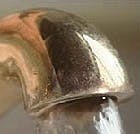States' information on water utility 90th percentile lead levels reported under the Lead and Copper Rule (LCR) "continues to show that there does not appear to be a widespread problem with elevated lead levels across the country comparable to that currently being observed in the District of Columbia," EPA reports in its latest summary of the data.
Building on its initial preliminary summary last month of LCR data from systems serving more than 50,000 people, the updated summary includes additional and corrected data from large systems, as well as new data from systems serving 3,300 to 50,000.
EPA emphasized, however, that problems with California’s data forced the agency to hold it in a separate database pending resolution of the problem, which it said stems from the state’s inconsistent entry of monitoring period start and end dates. The separate database includes California data from 80 of 150 large systems and 280 of 498 smaller systems.
The report shows that through June 1, data show that less than 4 percent of currently active community and noncommunity water systems have exceeded the LCR action level of 15 micrograms/L, with most 90th percentile readings coming in under 5 micrograms/L.
Large systems – For the 834 large systems serving 153.8 million people nationwide, USEPA reported that it had data for 744 (89 percent) of those systems that reported samples since 2000.
Of those 744, only 27 (3.6 percent) exceeded the action level (12 ranged from 26-100 micrograms/L, with one exceeding 100 micrograms/L), led by six in Massachusetts, five in Puerto Rico and four in Oregon.
USEPA noted that only 12 (3.8 percent) of 316 systems for which it has data for the more recent monitoring periods ending in 2003 and later exceeded the action level.
Smaller systems – For the 7,833 systems serving 3,300-50,000 people (a total of 94.4 million people nationwide), USEPA reported that it also had data from 89 percent of systems reporting since 2000.
Of those 6,958 systems, 237 (3.4 percent) exceeded the action level (91 of them ranged from 26-200 micrograms/L , with six exceeding 200 micrograms/L) led by 25 in Massachusetts, 17 in New Jersey, 16 in North Carolina and 13 each in Idaho and New York.
Of 2,442 systems for which USEPA has data from monitoring periods ending in 2003 and later, 76 (3.1 percent) exceeded the action level.
USEPA’s report also addresses how 177 systems that exceeded the action level in the first two rounds of monitoring following LCR promulgation in 1991 have fared since then. Of the 166 systems for which comparative data is available, 17 exceeded the action level during their most recent monitoring period, nine of which are part of the Massachusetts Water Resources Authority (MWRA) service area, which currently exceeds the action level. USEPA also noted that of nine systems that had initial 90th percentile readings exceeding 100 micrograms/L, five are now below the action level, two are within the MWRA service area, one continues to exceed the action level another is no longer in operation.
Source: AWWA


